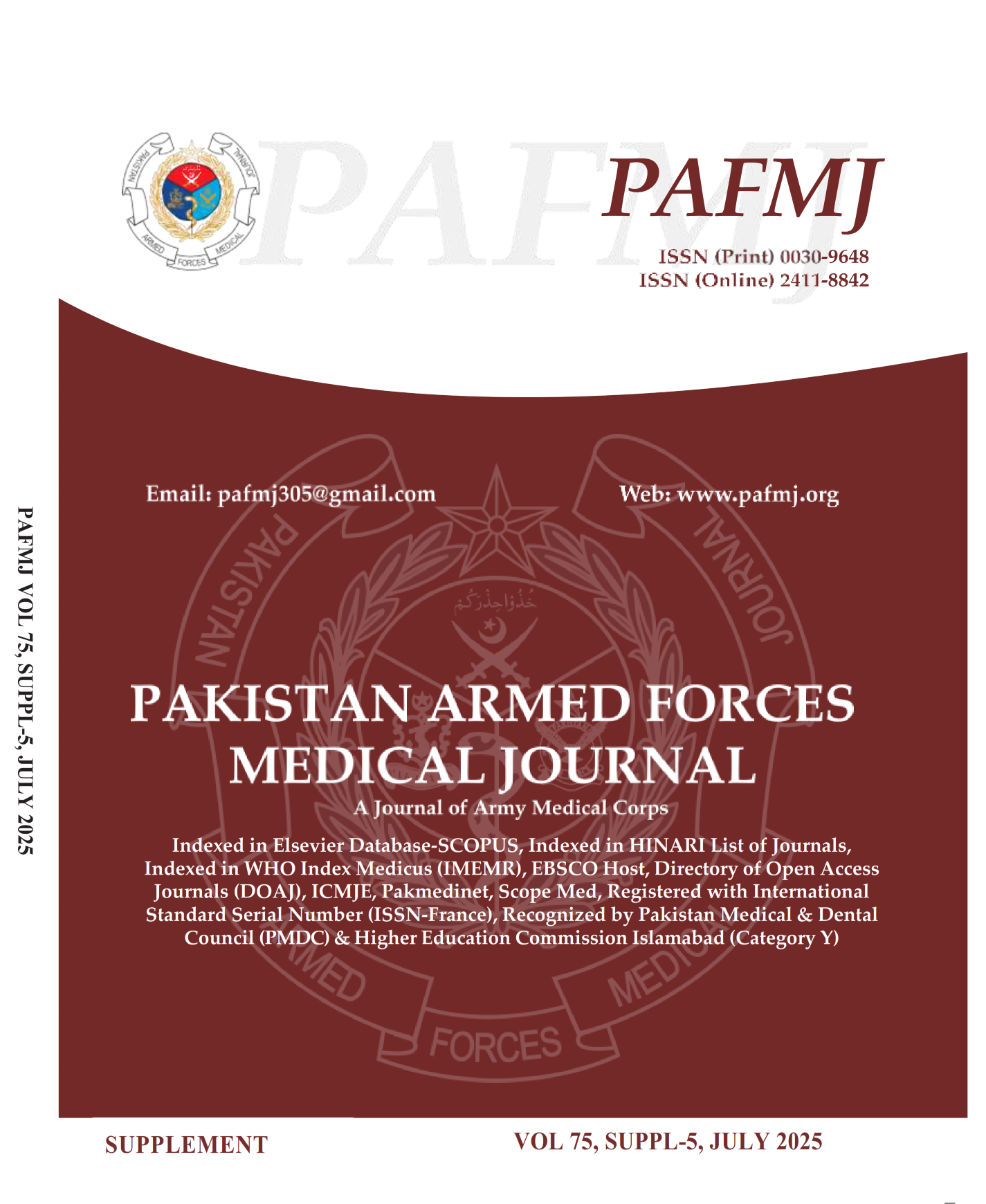Comparison of Frequency of Surgical Site Infection in Patients of Peritonitis Undergoing Laparotomy with Closed Wound and Drain Placed vs Open Wound Without Drain
DOI:
https://doi.org/10.51253/pafmj.v75iSUPPL-5.12052Keywords:
Laparotomy, Peritonitis, Surgical wound infection.Abstract
Objective: To compare of frequency of “surgical site infection (SSI)” in patients of peritonitis undergoing laparotomy with abdominal closure with subcutaneous drain placement versus open skin technique without drain.
Study Design: Comparative observational study.
Place and Duration of Study: Combined Military Hospital, Rawalpindi Pakistan, from Mar 2023-2024.
Methodology: A total of 240 patients who underwent laparotomy for peritonitis were included in the study and were divided into “abdominal closure with subcutaneous drain Group (A)” and “open skin technique without drain Group (B)”. At 30-days post-operative period, patients were assessed for presence of surgical site/wound infection. Data was analyzed by SPSS 20.
Results: Mean age was 40.98±8.81 years. There were 134(55.83%) males and 106(44.17%) were females. Most common reason for peritonitis was “intestinal perforation” 87(36.25%) followed by “perforated appendix” 78(32.50%) and “gastric ulcer perforation” 75(31.25%). In “closed wound with drain Group”/Group A, frequency of SSI was 12(10.00%) while in “open skin technique without drain Group”/Group B, it was 25(20.83%), respectively (p=0.020).
Conclusion: Frequency of SSI was significantly lower when wound was closed and a subcutaneous drain was placed as compared to open skin technique without drain.
Downloads
References
1. Hailu S, Ayinie A, Amsalu H, Hailu S, Tadesse M, Mamo T, et al. Perioperative mortality and its predictors among patients undergoing emergency laparotomy at selected southern Ethiopian governmental hospitals, 2022: a multicenter prospective cohort study. Ann Med Surg 2023; 85(4): 746-752.
https://doi.org/10.1097/MS9.0000000000000437
2. Barazanchi AWH, Xia W, MacFater W, Bhat S, MacFater H, Taneja A, et al. Risk factors for mortality after emergency laparotomy: scoping systematic review. ANZ J Surg. 2020; 90(10): 1895-1902. https://doi.org/10.1111/ans.16082
3. Rickard J, Pohl L, Abahuje E, Kariem N, Englbrecht S, Kloppers C, et al. Indications and outcomes for non-trauma emergency laparotomy: a comparison of Rwanda, South Africa, and the USA. World J Surg 2021; 45(3): 668-677.
https://doi.org/10.1007/s00268-020-05862-y
4. Kumar D, Garg I, Sarwar AH, Kumar L, Kumar V, Ramrakhia S, et al. Causes of acute peritonitis and its complication. Cureus 2021; 13(5): e15301.
https://doi.org/10.7759/cureus.15301
5. Petersen S, Deder A, Prause A, Pohland C, Richter D, Mansfeld T, et al. Transverse vs. median laparotomy in peritonitis and staged lavage: a single center case series. Ger Med Sci 2020; 18: Doc07. https://doi.org/10.3205/000283
6. Isbell KD, Hatton GE, Wei S, Green C, Truong VTT, Woloski J, et al. Risk stratification for superficial surgical site infection after emergency trauma laparotomy. Surg Infect (Larchmt) 2021; 22(7): 697-704. https://doi.org/10.1089/sur.2020.242
7. Harish R, Kazi FN, Sharma JVP. Efficacy of subcutaneous closed suction drain in reduction of postoperative surgical site infection. Surg J 2021; 7(4): e275-e280.
https://doi.org/10.1055/s-0041-1735900
8. Manzoor B, Heywood N, Sharma A. Review of subcutaneous wound drainage in reducing surgical site infections after laparotomy. Surg Res Pract. 2015; 2015: 715803.
https://doi.org/10.1155/2015/715803
9. Naik AK, Arya SV, Sharma AK. Role of subcutaneous suction drain in reducing surgical site infection in emergency laparotomy. Int Surg J 2022; 9(3): 616-619.
https://doi.org/10.18203/2349-2902.isj20220631
10. Ouf TI, Jumuah WAA, Mahmoud MA, Abdelbaset RI, Mortality rate in patients with secondary peritonitis in Ain Shams University Hospitals as regard Mannheim Peritonitis Index (MPI) score. QJM: Int J Med 2020; 113(Suppl 1):hcaa050.073.
https://doi.org/10.1093/qjmed/hcaa050.073
11. Wu XW, Zheng T, Hong ZW, Ren HJ, Wu L, Wang GF, et al. Current progress of source control in the management of intra-abdominal infections. Chin J Traumatol 2020; 23(6): 311-313.
https://doi.org/10.1016/j.cjtee.2020.07.003
12. Song SR, Liu YY, Guan YT, Li RJ, Song L, Dong J, et al. Timing of surgical operation for patients with intra-abdominal infection: A systematic review and meta-analysis. World J Gastrointest Surg. 2023; 15(10): 2320-2330.
https://doi.org/10.4240/wjgs.v15.i10.2320
13. Atumanyire J, Muhumuza J, Talemwa N, Molen SF, Kithinji SM, Kagenderezo BP, et al. Incidence and outcomes of surgical site infection following emergency laparotomy during the COVID-19 pandemic in a low resource setting: A retrospective cohort. Int J Surg Open 2023; 56: 100641.
https://doi.org/10.1016/j.ijso.2023.100641
14. Okishio Y, Ueda K, Nasu T, Kawashima S, Kunitatsu K, Masuda M, et al. Intraoperative techniques to prevent deep incisional or organ-space surgical site infection after emergency surgery for nonappendiceal perforation peritonitis: a prospective two-center observational study. Eur J Trauma Emerg Surg 2023; 49(5): 2215-2224. https://doi.org/10.1007/s00068-023-02301-0
15. Hendriksen BS, Keeney L, Morrell D, Candela X, Oh J, Hollenbeak CS, et al. Epidemiology and perioperative mortality of exploratory laparotomy in rural Ghana. Ann Glob Health. 2020; 86(1): 19.
https://doi.org/10.5334/aogh.2586
16. Neupane S, Koirala DP, Kharel S, Silwal S, Yadav KK. Clinical profile and management of perforation peritonitis in Bharatpur hospital, Nepal: A prospective study. Ann Med Surg. 2022; 82: 104528. https://doi.org/10.1016/j.amsu.2022.104528
17. Clements TW, Tolonen M, Ball CG, Kirkpatrick AW. Secondary peritonitis and intra-abdominal sepsis: an increasingly global disease in search of better systemic therapies. Scand J Surg. 2021; 110(2): 139-149.
https://doi.org/10.1177/1457496920984078
18. Khan MA, Azaz MA, Suleman S, Afreen U, Hafeez F, Muhammad A. Compare the surgical site infection in laparotomy with or without post-operative drainage. Pak J Med Health Sci. 2020;14(3):1076-1077.
19. Mathews MZ, Subramanyam SG, Mitta N. A prospective study in peritonitis patients to compare the impact of subcutaneous negative suction closure, conventional primary closure of skin and subcutaneous tissue and open skin technique following laparotomy. Int Surg J. 2019; 6(9): 3293-3296.
https://doi.org/10.18203/2349-2902.isj20194068
20. Manoharan GV, Sivakumar T, Kumar MA. Evaluation of the use of subcutaneous drains to prevent wound complications in abdominal surgeries. Int Surg J. 2018; 5(4): 1368-1372.
https://doi.org/10.18203/2349-2902.isj20181112
21. Mukherjee R, Samanta S. A comparative study of primary skin and subcutaneous tissue closure and open skin technique in emergency laparotomy for perforative peritonitis: an observational and prospective study. Int Surg J 2019; 6(1): 166-172.
Downloads
Published
Issue
Section
License
Copyright (c) 2025 Umar Nawab, Imran Ashraf, Aoun Ayub, Masood Tahir, Mehreen Nawab, Hamra Javed

This work is licensed under a Creative Commons Attribution-NonCommercial 4.0 International License.















